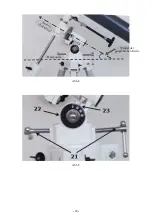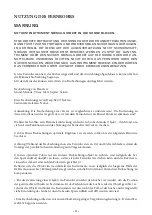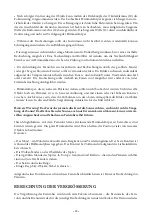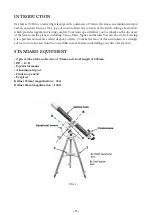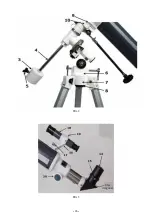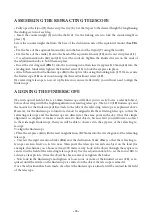
• 34 •
The maximum magnification is determined by the nature of the object observed and, more important-
ly, by the meteorological conditions. If the atmosphere is very calm, you can use the telescope 70/900
with up to 140x magnification. However, generally speaking, lower magnification between 25x and
100x will be the maximum admitted.
If you use the model 70/900 on a regular basis, it is advisable to have an assortment of four or five eye-
pieces. For example, a set of eyepieces of 40mm, 25mm, 12.5mm and 9mm will provide a respective
magnification range of 22.5x, 36x, 72x and 100x.
A very high quality Barlow lens will double the magnification with each eyepiece.
For planetary observations, advisable eyepieces are:
25mm, 12.5mm and 9mm.
For deep sky observations, advisable eyepieces are:
25mm and 40mm.
Remember that this refracting telescope is above all an instrument for planetary observations.
UNDERSTANDING CELESTIAL MOVEMENT AND
COORDINATES
Due to the Earth’s rotation, celestial bodies appear to move from East to West, following a curved tra-
jectory. The path that they follow is known as the line of Right Ascension (RA). The angle between the
celestial body and the celestial equator is called Declination (Dec).
Right Ascension and Declination are analogous to the coordinates system (latitude, longitude) used
on the surface of the Earth.
USING SETTING CIRCLES
Once the poles have been aligned, the setting circles on the equatorial mount (FIG 4) can help you to
locate celestial bodies that are not very visible, and that you would not discover through direct visual
observation.
The planets in the solar system: Mercury, Venus, Mars, Jupiter and Saturn are visible to the naked eye,
you will not need to use the setting circles to locate them.
Setting circles are only needed to locate certain objects in the deep sky (that are invisible to the naked
eye). However, for this, you must have aligned the poles beforehand, with absolute precision, which is
rarely the case on this type of set up, which is not equipped with a polar finder. In addition, this tech-
nique requires a stellar atlas of celestial coordinates.
Deep sky objects can be located using a simple map of Messier objects, for example.
You are now ready to embark on your journey of discovery as an amateur astronomer!
Your Mizar refracting telescope will offer you numerous nights of observation, full of wonder at the
beauty of the spectacle offered by the celestial sphere.
The reference guides available in-store at Nature et Découvertes will help you with any questions you
may have.
Summary of Contents for Mizar 70/900
Page 4: ... 4 FIG 2 FIG 3 ...
Page 5: ... 5 FIG 4 FIG 5 ...
Page 9: ... 9 FIG 8 FIG 9 ...
Page 15: ... 15 Abb 2 Abb 3 Zenitspiegel ...
Page 16: ... 16 Abb 4 Abb 5 Koordinatenringe D RA ...
Page 20: ... 20 Abb 8 Abb 9 Norden Polarstern Horizontal Winkel der geografischen Breite ...
Page 26: ... 26 FIG 2 FIG 3 Star diagonal ...
Page 27: ... 27 FIG 4 FIG 5 Setting circles Dec RA ...
Page 31: ... 31 FIG 8 FIG 9 Angle of latitude North polar star ...

